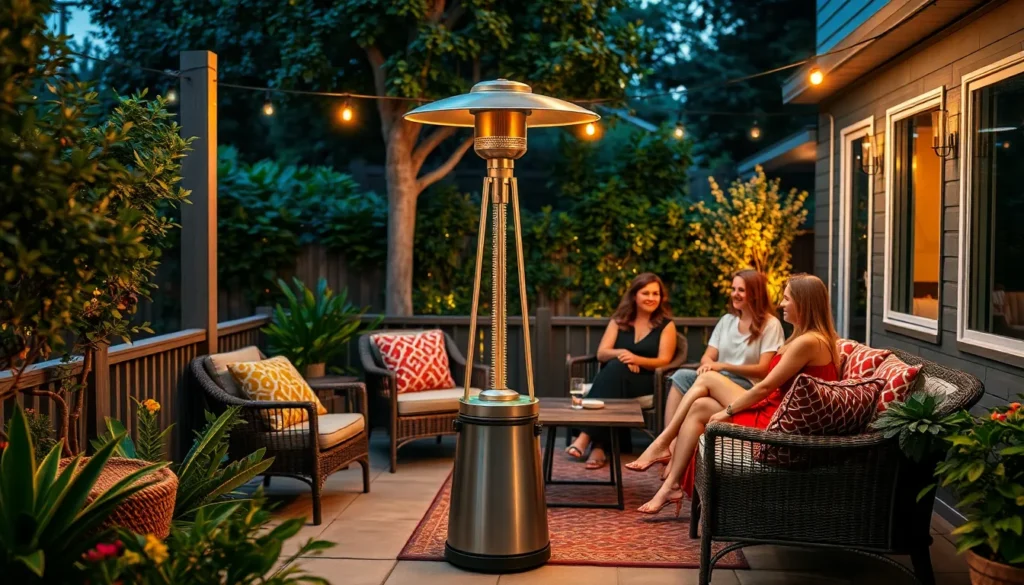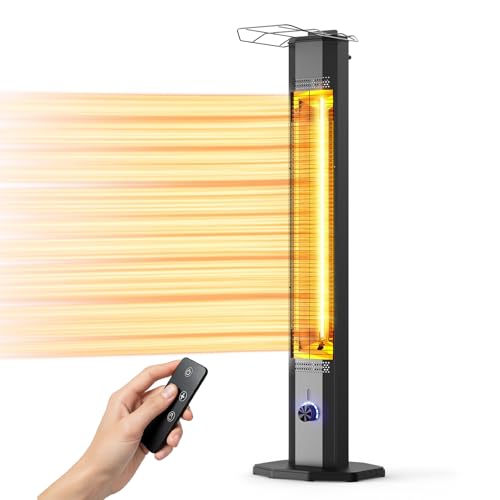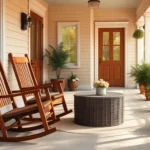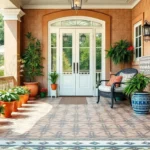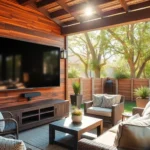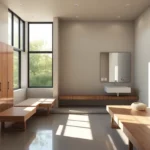When temperatures drop and evenings get chilly, we don’t have to abandon our beloved outdoor spaces. Patio heaters transform any deck, backyard, or garden into a year-round haven where we can continue entertaining guests and enjoying fresh air long after summer fades.
We’ve discovered that the right outdoor heating solution does more than just warm the air – it creates an inviting atmosphere that draws people together. From sleek propane towers that provide powerful heat coverage to charming fire pit tables that double as conversation pieces, today’s patio heaters blend functionality with stunning design.
Whether we’re hosting intimate dinner parties or simply want to extend our morning coffee ritual outdoors, strategic patio heating opens up endless possibilities for outdoor living. The key lies in choosing heaters that match our space, style, and heating needs while maximizing both comfort and visual appeal.
Choose the Right Type of Patio Heater for Your Space
Selecting the perfect patio heater depends on your outdoor space requirements and personal preferences. Each heating option offers distinct advantages that cater to different needs and installation possibilities.
Propane Gas Heaters for Maximum Heat Output
Propane heaters deliver powerful warmth that can heat areas up to 18 feet in diameter, making them ideal for larger outdoor spaces. These portable units produce between 40,000 to 48,000 BTUs of heat, ensuring comfortable temperatures even on the coldest nights.
Mobility becomes a major advantage since you can easily move propane heaters to different areas of your patio or deck. Most models feature wheels and lightweight designs that allow for effortless repositioning based on your gathering needs.
Quick setup requires minimal effort as propane heaters connect directly to standard 20-pound propane tanks. You’ll have instant heat without waiting for warm-up periods, perfect for spontaneous outdoor entertaining.
Electric Heaters for Easy Installation
Electric patio heaters offer convenience through simple plug-and-play operation that eliminates fuel storage concerns. These units work efficiently in covered areas and provide consistent heat output ranging from 1,500 to 5,000 watts.
Installation takes minutes since electric heaters only require access to standard electrical outlets. Wall-mounted and ceiling-mounted options maximize floor space while providing targeted heating zones.
Operating costs remain predictable as electric heaters run on your home’s power supply with no need for propane refills or wood purchases. Many models include remote controls and timer functions for enhanced user convenience.
Natural Gas Heaters for Permanent Answers
Natural gas heaters provide unlimited fuel supply through direct connection to your home’s gas line, eliminating the need for tank replacements. These units typically produce 30,000 to 50,000 BTUs of consistent heat output.
Professional installation ensures safety and optimal performance, though it requires a higher initial investment than portable alternatives. Once installed, natural gas heaters become permanent fixtures that add value to your outdoor living space.
Long-term savings accumulate since natural gas costs significantly less than propane per BTU, making these heaters economical for frequent use throughout heating seasons.
Wood-Burning Fire Pits for Rustic Charm
Wood-burning fire pits create ambiance that combines warmth with the crackling sounds and aromatic scents of burning wood. These heating answers serve as focal points that encourage gathering and conversation.
Fuel availability offers flexibility as you can use various wood types including hardwoods like oak and maple for longer burning times. Many fire pits accommodate wood logs up to 24 inches in length.
Cooking capabilities expand functionality since many wood-burning fire pits include grilling grates and cooking surfaces. You’ll enjoy the dual purpose of heating your space while preparing outdoor meals for your guests.
Position Your Patio Heater for Optimal Coverage
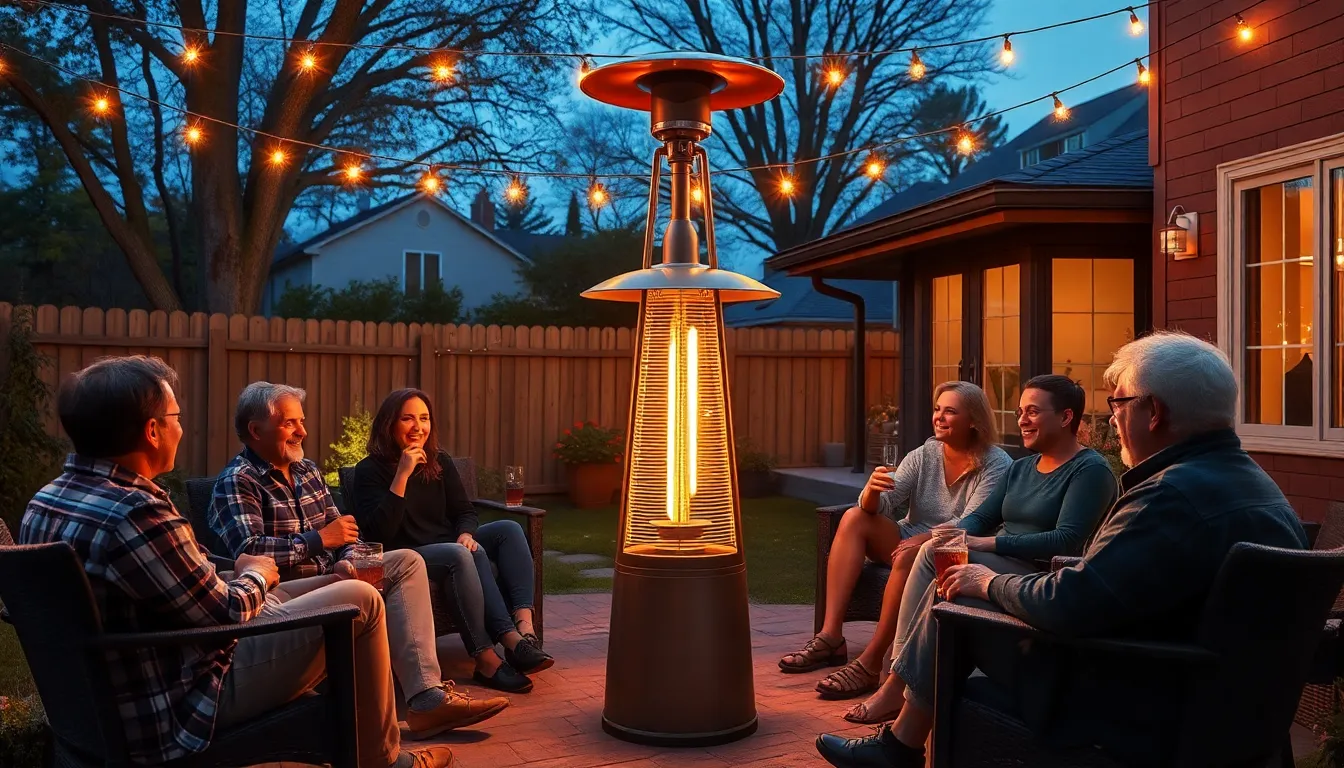
Once you’ve selected the perfect heater type for your space, strategic placement becomes crucial for maximizing warmth and comfort. Proper positioning ensures efficient heat distribution while creating the ideal atmosphere for outdoor gatherings.
Center Placement for Maximum Heat Distribution
Center placement works best when you’re dealing with open patios or larger outdoor spaces where even heat distribution is essential. We recommend positioning your patio heater in the center of your seating area to achieve uniform warmth that radiates in all directions.
This strategic positioning ensures everyone around your outdoor space receives equal comfort levels. Large dining tables, expansive lounge areas, and open entertainment zones benefit most from centered heater placement. Your guests won’t experience hot and cold spots that can make outdoor gatherings uncomfortable.
Corner Positioning for Intimate Seating Areas
Corner positioning creates cozy pockets of warmth perfect for smaller, more intimate outdoor settings. We find this placement ideal for defined seating zones like compact dining nooks, conversation areas, or romantic lounge sets.
Directing heat into exact areas allows you to create comfortable microclimates without overheating your entire patio. Corner placement works particularly well with sectional furniture arrangements or L-shaped seating configurations. Your intimate gatherings become more enjoyable when warmth is concentrated where people actually sit.
Multiple Heater Setup for Large Patios
Multiple heater configurations become necessary for expansive outdoor spaces where single units can’t provide adequate coverage. We calculate heater requirements by multiplying your patio’s length by width to determine total area, then dividing by each heater’s coverage capacity.
Electric heaters typically cover 10 to 12 square meters effectively, meaning a 24 square meter patio requires approximately two units for optimal warmth. Environmental factors like wind exposure and overhead coverage influence these calculations significantly. Installation height between 2 to 3 meters ensures optimal heat spread throughout your space.
Position each heater 1 to 2 feet in front of where people’s knees would be, angling them toward seat cushions for maximum comfort. Ceiling mounted units can be placed directly over seating areas but should angle toward cushions or straight down for best results.
Create Cozy Seating Arrangements Around Your Heater
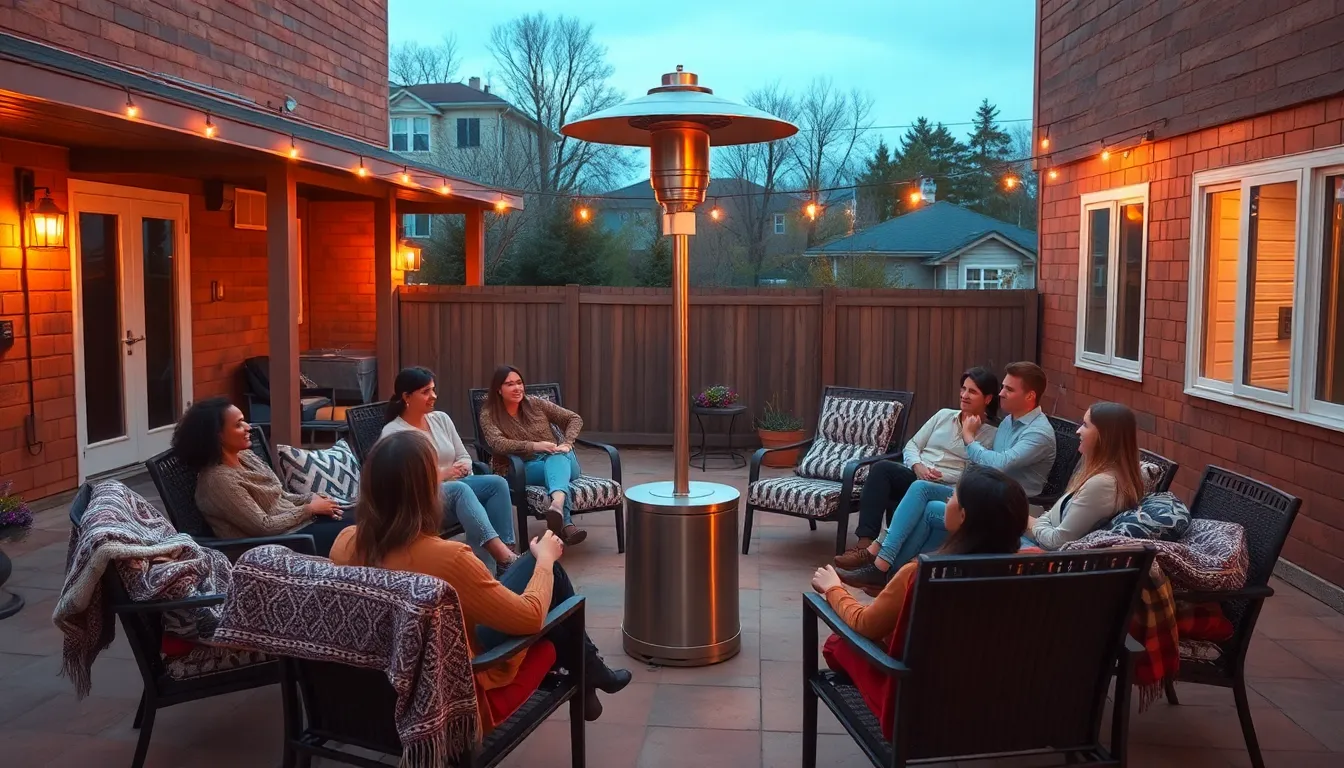
We can transform our outdoor heating experience by strategically arranging furniture around patio heaters. The right seating layout maximizes warmth distribution while creating inviting spaces for relaxation and entertainment.
Circular Furniture Layout for Social Gatherings
Circular arrangements around our patio heater encourage natural conversation flow and ensure equal warmth distribution for everyone. We position chairs or outdoor sofas in a circle around the central heater, creating a focal point that radiates heat evenly to all seated participants. This setup works particularly well for social gatherings where guests face each other, maximizing both interaction and comfort levels.
Creating this layout requires placing our heater at the center with seating positioned 4 to 6 feet away for optimal heat reception. We find that mixing different seating options like chairs and small benches adds visual interest while maintaining the circular flow. The arrangement naturally draws people together and creates an intimate atmosphere perfect for evening conversations.
L-Shaped Sectional Placement for Family Comfort
L-shaped sectionals offer both comfort and space efficiency, making them ideal for families or close-knit groups around our patio heater. We can position the sectional around a corner heater or pair it with wall-mounted heaters that warm multiple seating surfaces effectively. Wall-mounted heaters placed behind seating at 2 to 4 feet distance warm occupants’ backs and shoulders without creating harsh direct heat.
The L-shape creates a cozy nook that’s conducive to relaxation while maximizing our seating capacity. We recommend placing the heater at the corner intersection of the sectional to ensure both sides receive adequate warmth. This configuration works especially well for families who want to gather together while maintaining comfortable personal space.
Bench Seating for Space-Efficient Warmth
Bench seating maximizes our seating capacity while keeping everyone close to the heater’s warmth zone. We can accommodate more people with benches compared to bulky individual chairs, making this option perfect for smaller patios or when hosting larger groups. Mesh-back benches or stools enable radiant heat to pass through and reach occupants more effectively, increasing warmth distribution for everyone seated.
Strategic bench placement around our heater creates flexible seating that we can easily rearrange based on group size. We position benches in a semi-circle or straight line configuration depending on our space constraints and heater type. Adding layered blankets and cushions to bench seating enhances both warmth and comfort levels while creating an inviting outdoor experience.
Enhance Safety with Proper Heater Placement
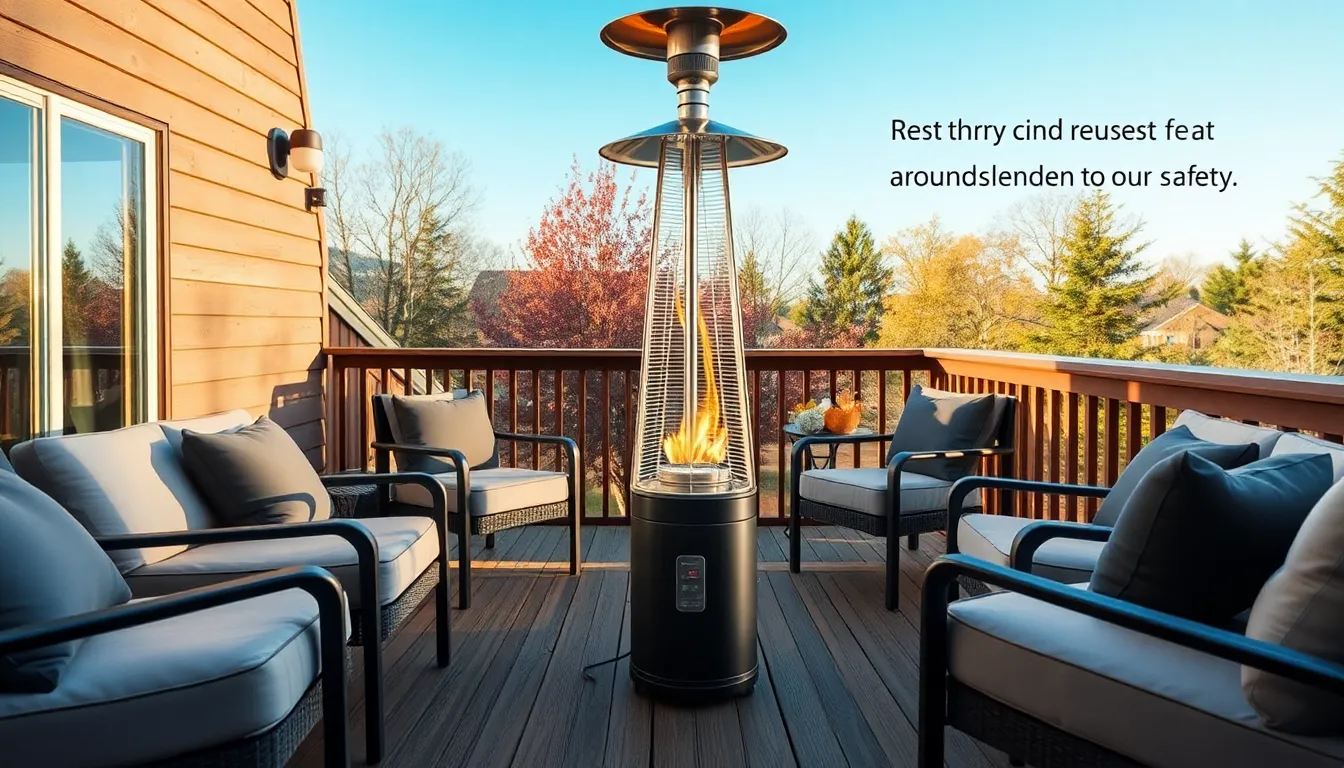
We prioritize safety when positioning our outdoor patio heaters to create a secure environment for everyone. Following proper placement guidelines ensures we maximize both comfort and protection while enjoying our outdoor heating systems.
Maintain Safe Distances from Structures
Outdoor spaces require careful consideration when positioning patio heaters near buildings and overhead structures. We maintain at least 3 feet of clearance on all sides of our heaters to prevent heat from affecting nearby objects and reduce fire risk. Gas and propane heaters must stay in open-air environments only, as using them in enclosed or screened-in porches creates dangerous carbon monoxide risks.
Overhead clearance deserves special attention when we install patio heaters beneath awnings or covered areas. We position our heaters at least 3 to 5 feet away from ceilings or overhead awnings to allow proper ventilation and avoid fire hazards. Flammable materials like fabrics, paper, or plastic need at least 3 feet of distance from our heaters to prevent accidental ignition.
Strategic placement away from exits and pathways ensures we don’t obstruct safe egress routes. We avoid positioning heaters near doorways, stairs, or main walkways where they might create obstacles during normal movement or emergency situations.
Secure Heaters on Level Surfaces
Stable positioning forms the foundation of safe patio heater operation in our outdoor spaces. We place all standing heaters on flat, stable surfaces to minimize the risk of tipping over, which can cause serious injury or property damage. Uneven ground, loose gravel, or sloped areas create dangerous conditions that we actively avoid.
Level surfaces provide the necessary stability for proper heater function and prevent accidental displacement. We check the ground beneath our heaters before each use, ensuring no rocks, debris, or soft soil might compromise stability. Concrete patios, wooden decks, and firmly packed earth offer the best foundation for secure heater placement.
Weight distribution plays a crucial role in maintaining heater stability throughout operation. We verify that our heaters sit evenly on their base without wobbling or tilting, making adjustments as needed to achieve perfect balance.
Install Wind Guards for Flame Protection
Wind protection enhances both safety and efficiency when we operate flame-based patio heaters in outdoor environments. We consider wind guards to shield flames from gusts, preventing accidental flame extinguishing or dangerous flare-ups that could pose safety risks.
Consistent flame control improves heating performance while reducing safety concerns during windy conditions. We position wind guards strategically around our heaters to maintain steady combustion without blocking heat distribution to seating areas. These protective barriers help us maintain optimal flame height and prevent erratic burning patterns.
Weather resistance becomes essential when we select wind guard materials for long-term outdoor use. We choose guards made from heat-resistant materials that can withstand temperature fluctuations while providing reliable wind protection throughout different seasons.
Incorporate Decorative Elements to Complement Your Heater
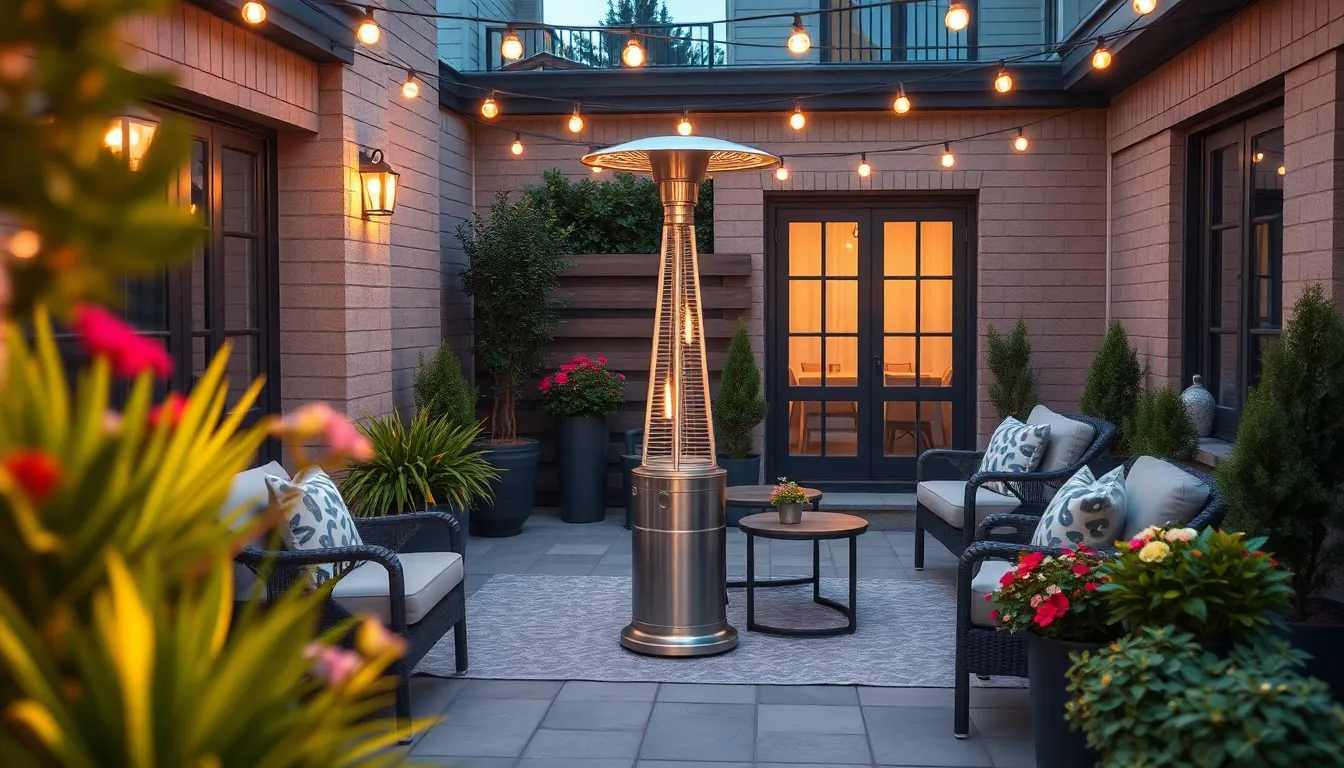
We’ve established the perfect heating setup and seating arrangement for our outdoor space. Now let’s transform our patio heater from a purely functional appliance into a stylish focal point that enhances our overall outdoor design.
Matching Furniture Styles and Colors
Selecting patio heaters that blend seamlessly with our existing outdoor furniture creates a harmonious and visually appealing space. Electric and gas heaters offer diverse finishes ranging from warm metallics to sleek stainless steel, allowing us to coordinate with our patio furniture’s style and color palette. Modern minimalist heaters work exceptionally well in contemporary spaces, while classic bronze finishes complement traditional outdoor settings.
We can maintain our design aesthetic by choosing wall-mounted units with clean lines for modern spaces or freestanding towers that echo our furniture’s materials. Coordinating our heater’s finish with our table bases, chair frames, or umbrella stands creates visual continuity throughout our outdoor area.
Coordinating Planters and Greenery
Integrating planters and greenery around our patio heater softens the mechanical appearance of heating equipment while creating natural warmth and coziness. Strategic placement of potted plants and coordinated planters helps define our heated zones and provides visual barriers that make our space feel more intimate.
Matching our planter materials and colors to our heater finishes and furniture creates a cohesive outdoor room design. Large planters filled with evergreen shrubs or seasonal flowers can frame our heater area, while smaller accent plants add texture and color. This approach transforms our heating zone into a garden-like retreat that feels both functional and beautiful.
Adding Ambient Lighting for Evening Atmosphere
Combining ambient lighting with our patio heaters dramatically enhances our evening outdoor experience and extends usability well after dark. Many heaters feature built-in lighting elements, while others pair beautifully with string lights, lanterns, or LED fixtures to create both visual and physical warmth.
Dual head heaters with wider heat coverage provide an attractive warm glow that complements our conversation areas perfectly. String lights draped around our heated seating area create a magical atmosphere, while lanterns placed strategically near our heater add intimate lighting that enhances the cozy ambiance. We can layer different lighting sources to create depth and visual interest while maintaining the functional benefits of our heating system.
Maximize Heat Efficiency with Smart Design Choices
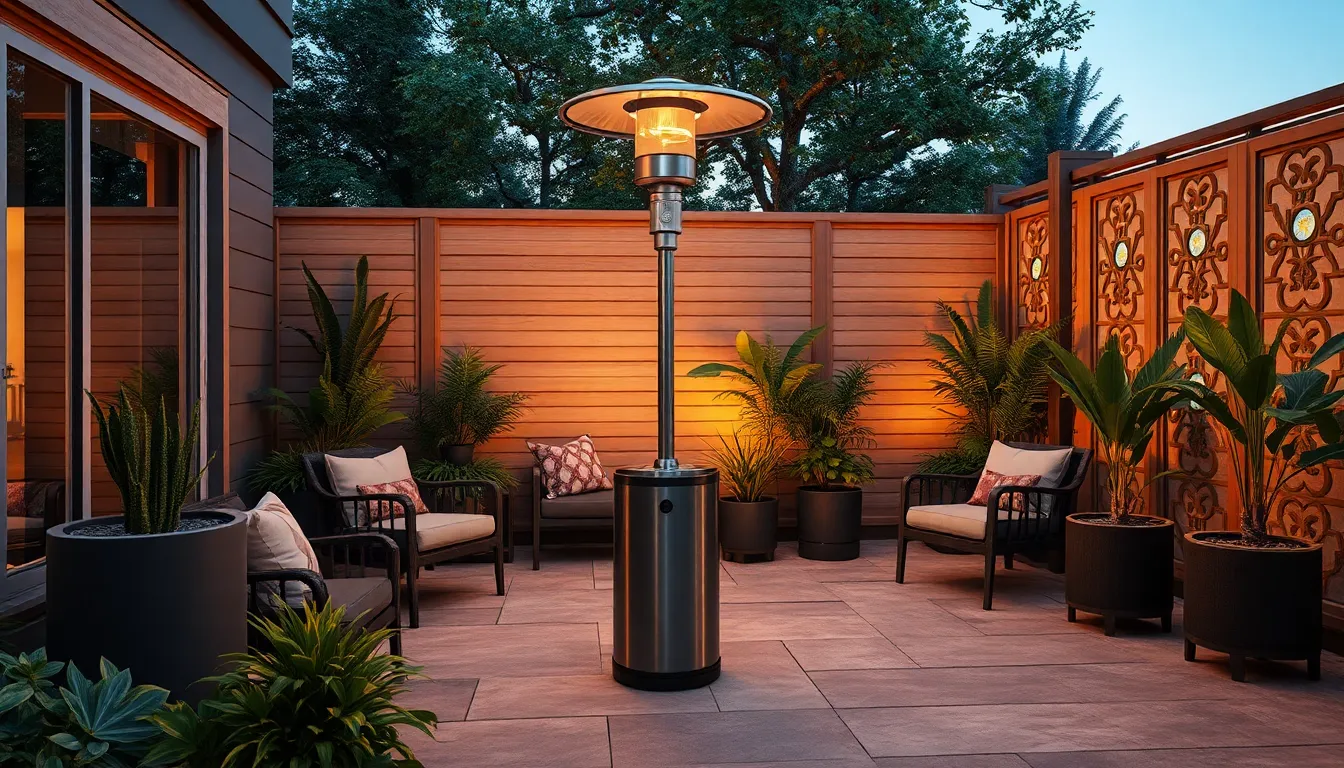
Smart design choices can dramatically increase your patio heater’s effectiveness while reducing energy costs. We’ll explore three proven strategies that boost heat retention and distribution.
Use Reflective Surfaces to Redirect Heat
Reflective surfaces transform wasted heat into valuable warmth by bouncing infrared energy back toward your seating area. Metallic panels positioned behind or around your heater create a heat mirror that doubles the warming effect without burning extra fuel.
Heat reflective paint on nearby walls or ceilings amplifies mounted heaters’ performance significantly. We recommend applying this specialized coating to surfaces within 6 feet of your heater for maximum impact.
Stainless steel or aluminum sheets mounted on frames offer portable reflection options. These materials redirect heat efficiently while maintaining weather resistance throughout the seasons.
Install Windbreaks and Privacy Screens
Wind disperses warm air faster than any other factor, making windbreaks essential for efficient patio heating. Weather resistant curtains create instant protection while adding style and privacy to your outdoor space.
Decorative screens serve dual purposes by blocking wind and improving your patio’s aesthetic appeal. We suggest positioning these barriers on the windward side of your heater to create a sheltered microclimate.
Retractable panels provide flexibility for changing weather conditions and social situations. These adjustable barriers let you control airflow while maintaining open sightlines when desired.
Strategic evergreen plantings offer natural wind protection year round. Boxwood hedges, arborvitae, or ornamental grasses create living windbreaks that improve with time.
Choose Heat Retaining Materials for Flooring
Stone pavers absorb radiant heat during the day and release it slowly throughout the evening hours. This thermal mass effect extends your patio’s warmth well after sunset without additional energy consumption.
Brick flooring captures heat from both solar radiation and your patio heater’s output. These materials store thermal energy and gradually radiate it back into your space, creating comfortable temperatures.
Concrete pavers offer excellent heat retention at budget friendly prices. We recommend darker colors that absorb more solar energy during daylight hours.
Natural flagstone provides superior thermal mass while adding elegant texture to your outdoor space. This material retains heat longer than most alternatives, making it ideal for areas with frequent temperature swings.
Consider Seasonal Storage and Maintenance Options
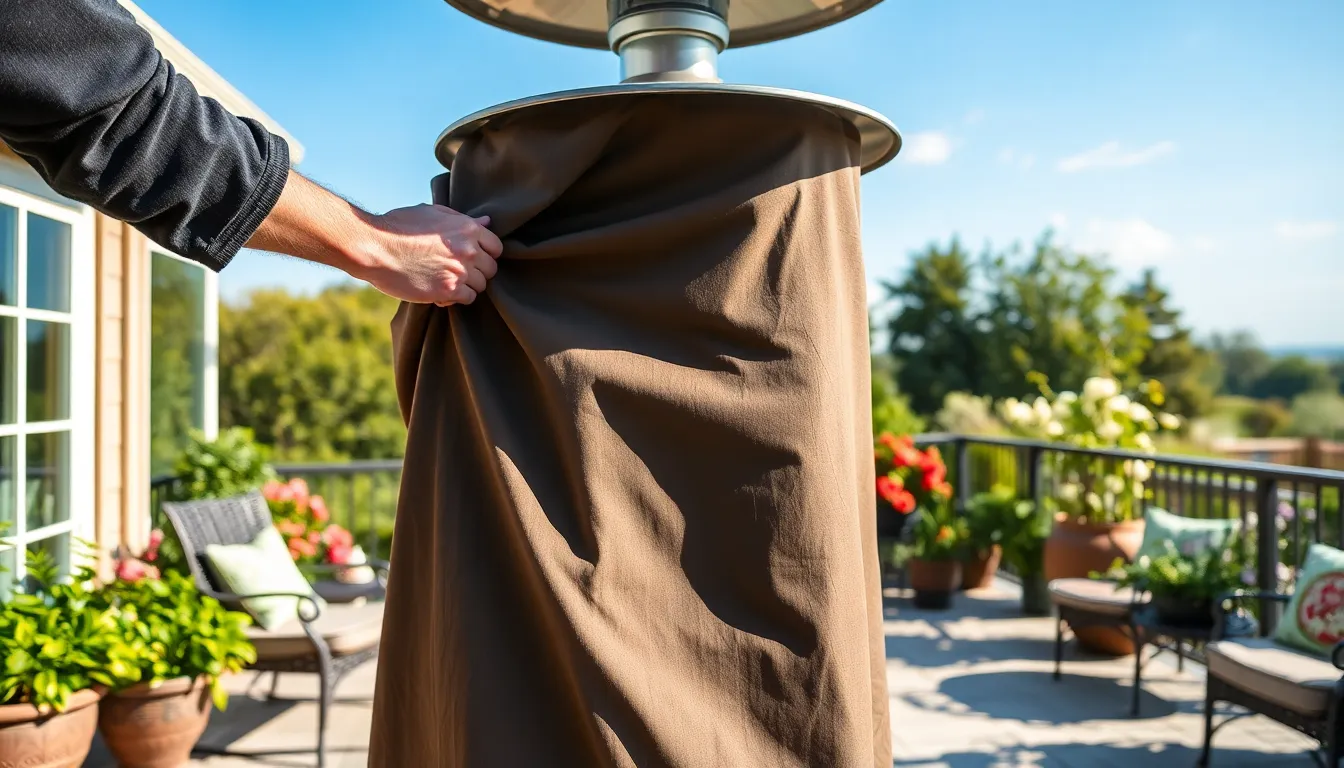
Proper care and maintenance significantly extend the lifespan of outdoor patio heaters while ensuring safe operation throughout multiple seasons. We’ll explore essential storage answers and maintenance practices that keep your heating investment performing optimally year after year.
Weatherproof Covers for Year-Round Protection
Durable covers protect against rain, snow, UV rays, and debris that can cause corrosion and electrical damage to outdoor heating equipment. High-quality weatherproof covers should be breathable to prevent moisture buildup while fitting securely over the entire heater structure.
UV-resistant materials prevent cover deterioration from constant sun exposure during warmer months. We recommend selecting covers made from heavy-duty polyester or vinyl that resist tearing and fading over time.
Proper ventilation prevents condensation issues that lead to rust formation on metal components. Look for covers with built-in vents or breathable fabric panels that allow air circulation while blocking moisture.
Custom-fit designs ensure complete protection for different heater styles and sizes. Measure your patio heater’s dimensions carefully to select covers that provide adequate coverage without being too loose or tight.
Easy Assembly Features for Seasonal Use
Modular designs simplify seasonal setup and takedown with clearly labeled parts and straightforward assembly instructions. Many modern patio heaters feature tool-free assembly systems that reduce installation time significantly.
Pre-drilled mounting systems streamline installation for electric patio heaters that require wall or ceiling attachment. Manufacturers typically include mounting brackets and hardware for quick seasonal installation and removal.
Quick-connect fittings reduce setup complexity for propane and natural gas models. These connections allow for fast attachment and disconnection of fuel lines without requiring specialized tools or professional assistance.
Lightweight construction materials enable easy repositioning during seasonal transitions. Aluminum and composite materials provide durability while maintaining portability for storage and setup changes.
Regular Cleaning and Inspection Schedules
Monthly cleaning maintains efficient heat distribution by removing residue from heater surfaces, reflectors, and burner components. Clean components ensure even heat output and prevent performance degradation over time.
Safety inspections should check for gas leaks in propane and natural gas models using soapy water answers applied to connection points. Bubbling indicates potential leaks that require immediate attention before continued use.
Electrical component inspections prevent safety hazards by identifying damaged wiring, loose connections, or worn-out parts. Replace any damaged electrical components immediately to maintain safe operation.
Manufacturer maintenance schedules provide exact guidelines for cleaning frequency and inspection intervals. Following these recommendations maintains warranty coverage and reduces safety risks throughout the heating season.
| Maintenance Task | Frequency | Key Focus Areas |
|---|---|---|
| Surface Cleaning | Monthly | Reflectors, burners, exterior surfaces |
| Gas Leak Inspection | Before each season | Connection points, hoses, fittings |
| Electrical Check | Bi-annually | Wiring, switches, heating elements |
| Component Replacement | As needed | Worn parts, damaged connections |
Budget-Friendly Patio Heater Ideas and Alternatives
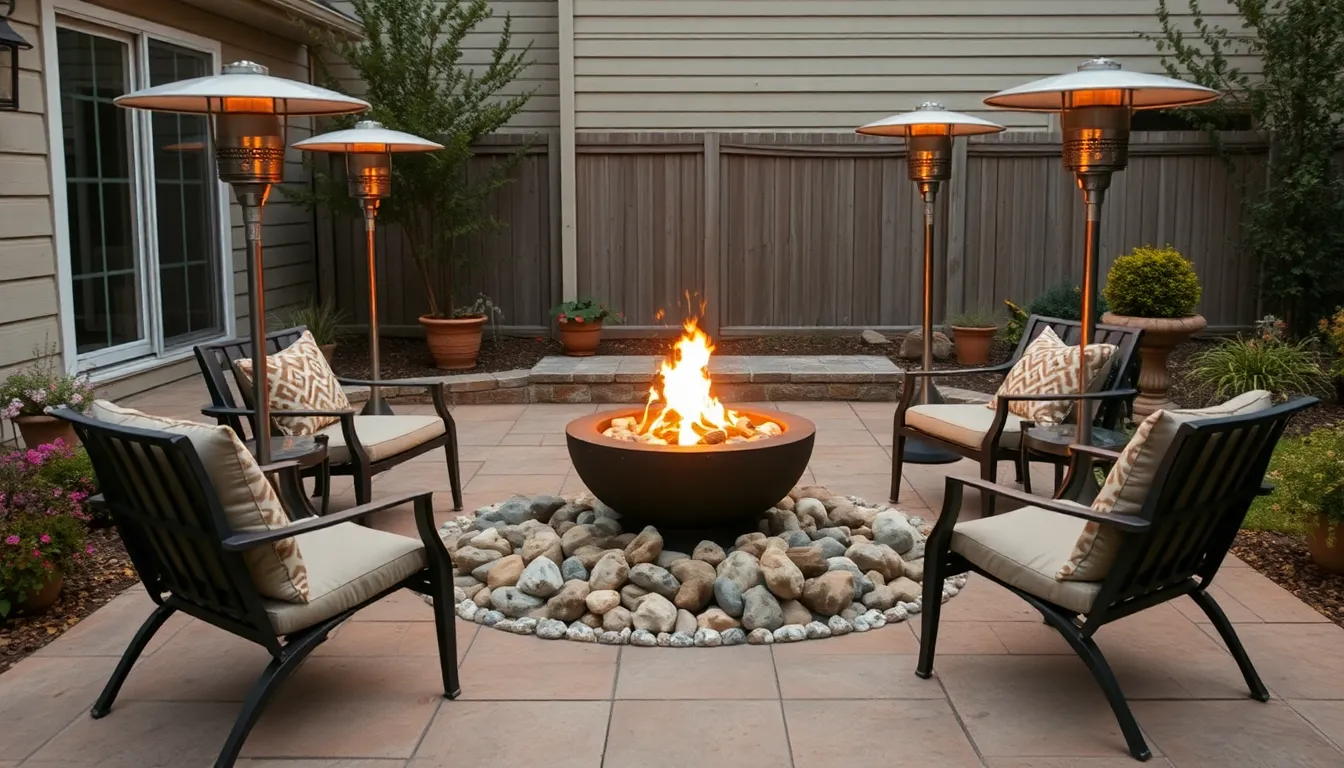
Creating warmth in your outdoor space doesn’t require very costly. We’ve discovered that smart heating answers can transform your patio into a cozy retreat without the hefty price tag.
DIY Fire Bowl Projects
Building your own fire bowl offers an economical and customizable heating solution that perfectly fits your style preferences. We recommend starting with metal bowls or repurposed planters as your base materials, which you can outfit with fire glass or lava rocks for enhanced visual appeal.
Adding a propane burner kit allows you to control the flame intensity while maintaining safety standards. You’ll find that customization options include choosing your preferred size, selecting decorative stones, and picking fuel types that match your usage patterns.
Creating these fire bowls lets you design unique heating elements that complement your existing outdoor décor. We suggest placing them strategically to serve as both functional heaters and attractive focal points for your patio gatherings.
Portable Heater Options Under $200
Finding quality portable heaters within budget requires focusing on exact types that deliver reliable performance. Portable propane heaters consistently offer the best value in this price range, providing efficient heat coverage for smaller patios while maintaining easy mobility.
Electric portable heaters present another affordable option, though they typically cover smaller areas compared to their propane counterparts. We’ve found that models like the Bromic Tungsten Smart Heat efficiently warm around 215 square feet using liquid propane tanks.
Searching for quality units under $200 requires patience, as products like the Hiland HLDS01-GTCB pyramid patio heater retail around $280. But, seasonal sales and clearance events often bring premium models within your budget range.
Multi-Purpose Heaters with Cooling Features
Maximizing your investment means choosing heaters that serve multiple functions beyond just warming your space. Fire pits with grill tops excel at providing heat while enabling barbecue and roasting activities, making them perfect for outdoor entertaining.
Models designed for simultaneous heating and food preparation enhance utility by warming guests during cooking sessions. We recommend these dual function units for families who frequently host outdoor gatherings, as they eliminate the need for separate heating and cooking equipment.
Multi-functional heating units create captivating focal points where people naturally gather, combining the warmth of a heater with the social aspect of shared meal preparation. These versatile options maximize your outdoor space’s functionality while keeping costs reasonable.
Conclusion
With the right patio heater setup we can transform our outdoor spaces into year-round retreats that bring comfort and style together. The key lies in balancing our heating needs with smart placement decorative touches and safety considerations.
Whether we’re working with a generous budget or looking for cost-effective answers there’s always a way to add warmth to our outdoor gatherings. From DIY fire bowls to high-end gas towers the options are endless when we focus on what works best for our exact space.
Remember that the best patio heater isn’t just about heat output—it’s about creating an inviting atmosphere where friends and family want to spend time together regardless of the season.
Frequently Asked Questions
What are the main types of patio heaters available?
The main types include propane gas heaters (powerful heat output with mobility), electric heaters (simple installation with consistent heat), natural gas heaters (permanent solution with lower long-term costs), and wood-burning fire pits (rustic charm with dual functionality for heating and cooking).
How should I position my patio heater for maximum coverage?
For open spaces, place heaters in the center for maximum heat distribution. In smaller, intimate settings, corner positioning creates cozy warmth pockets. For larger patios, you may need multiple heaters based on area size and coverage capacity calculations.
What seating arrangements work best around patio heaters?
Circular furniture layouts encourage conversation and equal warmth distribution for social gatherings. L-shaped sectionals work well for families, providing comfort and space efficiency. Bench seating maximizes capacity and warmth in smaller areas.
What safety precautions should I follow when using patio heaters?
Maintain at least 3 feet of clearance on all sides from structures to prevent fire risks. Keep heaters 3-5 feet away from ceilings or awnings. Secure heaters on level surfaces to prevent tipping, and use wind guards to protect flames from gusts.
How can I make my patio heater more aesthetically appealing?
Match heater styles and colors with existing outdoor furniture for cohesive design. Add planters and greenery around heaters to soften their appearance. Incorporate ambient lighting to create a warm, inviting atmosphere for evening gatherings.
What materials help maximize heat efficiency?
Use reflective surfaces like metallic panels or heat-reflective paint to redirect warmth toward seating areas. Install windbreaks and privacy screens to protect against heat-dispersing wind. Choose heat-retaining flooring materials like stone pavers, brick, or concrete.
How often should I maintain my patio heater?
Perform monthly surface cleaning, seasonal gas leak checks, and bi-annual electrical inspections. Use weatherproof covers made from durable, UV-resistant materials when storing heaters. Regular maintenance extends lifespan and ensures safe operation.
Are there budget-friendly patio heater alternatives?
Yes, try DIY fire bowl projects using metal bowls or repurposed planters with propane burner kits. Portable propane heaters under $200 offer good value for smaller patios. Multi-purpose heaters like fire pits with grill tops provide additional functionality.

